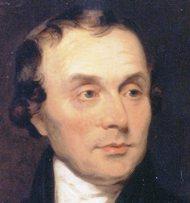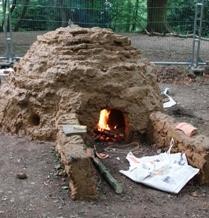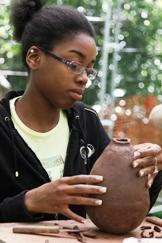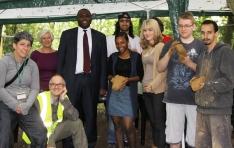Heritage Projects
Local Hero - Luke Howard FRS (1772-1864): The Man Who Named the Clouds

To celebrate the 350th anniversary of the Royal Society (external link) in 2010, the society supported many museums around the country to celebrate and honour its local scientific heroes.
At Bruce Castle Museum, we held an exhibition with an associated event programme for schools and the community to celebrate the life and achievements of local hero Luke Howard FRS (Fellow of the Royal Society), a chemist and founder of Howard & Sons pharmaceutical company. It was Luke's interest and scientific analysis of the weather and cloud formations that led him to become known as the Father of Meteorology. He lived and died at No 7 Bruce Grove, Tottenham, where an English Heritage Blue Plaque (Tottenham's only Blue Plaque, unveiled in 2002) celebrates Luke Howard's life and local connection - the 'Namer of Clouds lived and died here'.
The exhibition and project also gave an opportunity of working with the Royal Meteorological Society (etxernal link) - who kindly loaned John Opie's portrait of Luke Howard as well as a small number of original watercolour studies of cloud formations by Luke Howard - as well as Imperial College London's research academics working in Atmospheric Physics (external link). Together we worked to develop a prototype weather station roadshow for schools and the community and also to create an animated educational film The Man Who Named the Clouds, funded by the Opal programme (external link), that you can watch here:
The Invention of Clouds: Luke Howard, the Father of Meteorology
Note for iPhone users and Youtube. There is a known bug with iOS and Youtube, Two buttons are read before the player but provide no functionality. We advise that you skip these to access the content.
We were also supported with specialist talks by the environmental writer and historian Richard Hamblyn (external link), who had written an historical biography about Luke Howard, and the externded family of descendants of Luke Howard (external link), some of whom kindly loaned rare weather books and historical items of interest once owned by Luke Howard for the exhibition. These were exhibited alongside a number of items from Bruce Castle Museum and Haringey Archive's own collections. Latterly, we had promotional support for the exhibition and project by Gavin Pretor-Pinney (author of 'The Cloudspotter's Guide') and The Cloud Appreciation Society (external link).
Inspired by local hero Luke Howard and the clouds, since Bruce Castle Museum's own exhibition in 2010, local historians and the community have gone on to remember him still by creating a local group and website called Tottenham Clouds. In 2011, descendants of Luke Howard were reinvigorated to track down the gravestones for Luke and his wife Mariabella Howard, known to be buried at The Friends' Meeting House at Winchmore Hill. The full story is referenced here (external link).
Artists have also been inspired in the locality by the clouds and Luke Howard - with artist Natasha Vicars' deckchair installation in 2014, a portrait of Tottenham in Clouds presented at the Canalogy Festival and at the V&A's Tottenham Takeover; and more recently, Sky Puddles (external link), a site-specific installation by Carolina Khouri, in the courtyard of the Bernie Grant Arts Centre.
Luke Howard was celebrated on the 150th anniversary of his death in 2014 with the Tottenham Ploughman's CloudFest food and drink event (external link), dedicated to clouds and Luke Howard, at the Bruce Grove Youth Centre. On this occasion too, local cheesemakers Wildes Cheese produced a new cheese in his name - the Howard.
Haringey Potter
Haringey Potter: Re-creating the Highgate Roman kiln
 Stories of the World: London was one of the major projects at the heart of the London 2012 Cultural Olympiad. The Cultural Olympiad used the power of the Olympic and Paralympic Games to inspire creativity across all forms of culture, especially amongst young people.
Stories of the World: London was one of the major projects at the heart of the London 2012 Cultural Olympiad. The Cultural Olympiad used the power of the Olympic and Paralympic Games to inspire creativity across all forms of culture, especially amongst young people.
Bruce Castle Museum was one of a cluster of organisations that undertook an individual project in 2010, leading to a major exhibition at the Museum of London in 2012.
Background
In 1962, London archaeologist Harvey Sheldon (Birkbeck College, University of London) discovered a Roman pottery production kiln site in Highgate Wood. Harvey and his team excavated one of the kilns. It is still the oldest to be found in London. The kiln is presently kept at Bruce Castle Museum, although not all on display.
During the summers of 1971 to 1973 Nick Peacey and archaeologist Harvey Sheldon constructed a number of replica kilns in Highgate Wood, with re-enactments of the Roman firings. Our youth project was based on these original experiments - to discover how the Romans made and used the original kiln and how they created such dark-coloured pottery.
In July 2010, young people from Haringey came together for our Haringey Potter project to re-create the Highgate Roman kiln in Highgate Wood, under the supervision of veteran kiln-builder, Nick Peacey.
 It was quite a challenge to do this in just two weeks. However, our dozen or so young people successfully built a kiln from the clay under their feet and made pottery from the very same material. The successful final firing of the kiln ensured not only their pots survived but a 'reduction' process was achieved (i.e. creating a kiln atmosphere where oxygen is reduced and the flames pull oxygen molecules out of the clay to change its character) - something not accomplished in the experiments over 40 years ago! The young people had successfully discovered the Roman method of making pots and firing them in such a way to make them dark-coloured rather than a light terracotta. Our pots clearly match the examples of Roman pottery found on the site, making a real connection between today and 2,000 years ago.
It was quite a challenge to do this in just two weeks. However, our dozen or so young people successfully built a kiln from the clay under their feet and made pottery from the very same material. The successful final firing of the kiln ensured not only their pots survived but a 'reduction' process was achieved (i.e. creating a kiln atmosphere where oxygen is reduced and the flames pull oxygen molecules out of the clay to change its character) - something not accomplished in the experiments over 40 years ago! The young people had successfully discovered the Roman method of making pots and firing them in such a way to make them dark-coloured rather than a light terracotta. Our pots clearly match the examples of Roman pottery found on the site, making a real connection between today and 2,000 years ago.
Local potter Mooki Hurst led workshops to encourage participants to enjoy freedom in their creativity and guide them towards achieving the best results. Young people from local award-winning magazine Exposure recorded much of the project, showcasing the viewpoint of the participants.
A selection of the pots made and the accompanying film were on display at a major temporary exhibition (of this project and others) at the Museum of London in 2012. Some of the pots are now on permanent display at Bruce Castle Museum.
 In 2018, Bruce Castle Museum are currently working with the Friends of the Highgate Roman Kiln (FoHRK) - led by Nick Peacey, Harvey Sheldon, Michael Hammerson and Catherine West MP - and Highgate Wood staff to create a Heritage Lottery Funded project to return and display the original Roman kiln back as an educational resource in Highgate Wood.
In 2018, Bruce Castle Museum are currently working with the Friends of the Highgate Roman Kiln (FoHRK) - led by Nick Peacey, Harvey Sheldon, Michael Hammerson and Catherine West MP - and Highgate Wood staff to create a Heritage Lottery Funded project to return and display the original Roman kiln back as an educational resource in Highgate Wood.
If you are interested in making a donation to see the original Roman kiln returned permanently to Highgate Wood, or would like to register your interest in this project, please contact FoHRK on email: forkhw@virginmedia.com or staff at Highgate Wood on highgate.wood@cityoflondon.gov.uk
Haringey Potter Participants
Recruited in partnership with Haringey Youth Service, our participants in the project came from a variety of backgrounds. Some had experience of pottery but none had built a kiln before. They are all proud to have been part of the history of pottery in their area. They are all Haringey Potters.
| Photograph | Young participants' comments |
|---|---|
 | I never thought making pots and ceramics could be this much fun and so straightforward. Hopefully the rebuilding of the Roman Kiln instigates a new wave of people taking an interest in pottery, at Highgate Wood. I’m thinking of checking out pottery courses in the future myself. It was really fun being outdoors the whole time, in such a nice wood, getting to know people better and working together on something that other people will see for the next few years and wonder what it was about, and how it was built. No matter how damaged the kiln might be, I’m pretty sure they can't destruct the base! If the Roman kiln can survive 2000 years, so can this one! |
 | The opportunity of experiencing pottery in its truest form was great, there were no machines and the clay was fresh from the soil of the earth. This unique aspect caused the activity to hold great significance. I was uncertain about working outdoors but once I began my pottery I was so engaged that the weather became the least of my problems.My greatest achievement from this experience is that I gained various pottery skills, and I recognise this as a valuable opportunity. |
 | I really enjoyed the project and I'm glad that I took part. It gave me the opportunity to meet new people, try something different and expand my knowledge of the area's local history. Overall I'd say I that my favourite aspect of the task was making my own pottery, owing to my artistic background, although I enjoyed helping to build the kiln as well. |
 | Building the kiln was a great deal of fun - we created an entertaining atmosphere. I also enjoyed interacting with the local people around Highgate Wood and answering their questions concerning the project. Learning to think strategically about reconstructing a Roman kiln was a very rewarding part of this project. |
 | Creating pottery from a Roman kiln that you’ve built yourself, using the clay from the ground to create the pots in the same way that the romans did 2000 years ago – it’s something I’ll never forget. |
 | I had a wonderful experience because I learned a lot about the history of clay. Before doing this project I had made a variety of clay pieces, from leather boots to faces that looked like they were found in graveyards, but nothing compared to this. I was always used to an electric kiln so it was interested to see where it originated from and great to be part of making a kiln. A sensational experience I will never forget! |
 | It has been an incredible experience to be able to recreate a process which was taking place on this site nearly 2000 years ago. We’ve all learned a great deal about building and using a Roman kiln… the project has made the subject accessible and fascinating for everyone. |
 | Throughout the two weeks of the project, I’ve had a great practical experience learning about how Roman kilns were made... overcoming different obstacles in the process of building to ensure that our kiln would work. I have also learned some of the skills required to make a pot by hand, and to see it fired successfully |
 | Haringey Potter was interesting, fun and relaxing. Learning about Roman pottery was quite different for me but the amount of knowledge I gained from the 2 weeks on site was immense. Being in the Woods was stress-relieving and it brought back my youth. Knowing I recreated something that the Romans did gave me a feeling of great achievement. Just being a part of this community event felt very rewarding and I would love to do something like this again. |
 | This was my first exposure to the experimental side of archaeology. Although frustrating at times it was a great deal of fun to build the kiln and to fire our pots. The project has given me a much clearer vision of where I want to take my career in Archaeology when I finish my degree. |
| Filename | Filetype | Size |
|---|---|---|
| Re-creating the kiln in the early 1970s.pdf | 5.79 MB | |
| The Roman Pottery production site in Highgate Woods.doc | DOC | 61 KB |
